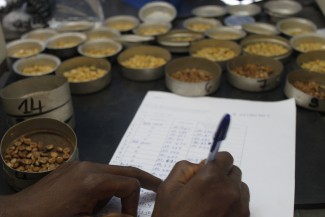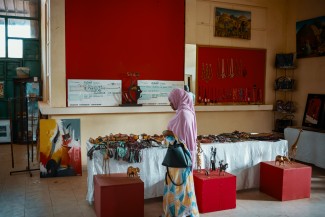Women could have a big impact on struggling economies, with studies showing improved gender parity goes hand-in-hand with greater growth. Yet least developed countries (LDCs) face considerable hurdles in improving women’s lives and realizing these benefits.
LDCs are home to approximately one billion people – a figure set to increase by 33% by 2030. From Burkina Faso to Cambodia to Kiribati, many LDCs are striving to transform precarity into power. With G20 countries playing a major role as investors, donors and development partners to support LDC progress, the advancement of LDC women is critical to achieving this goal.
The W20, the G20’s official engagement group on women, is presenting a Communiqué to G20 leaders at the 2019 summit in Osaka that urges action to close the global gender gap and offers specific recommendations. Given LDCs’ particular constraints in attaining gender equality, here are four ways to lift up their women and, simultaneously, the world’s poorest countries.
1. Make trade safe for women
Women drive trade on the busy borders between Rwanda, the Democratic Republic of the Congo (DRC) and their neighbours. They do so while facing security issues and harassment, carrying heavy loads and waiting in long lines, all with a lack of childcare and information about customs rules.
Simire Cibolonza, a DRC trader, now has stronger ties to the women in Rwanda from whom she regularly buys cabbages. This is a result of a newly signed trade agreement between the two countries, which have experienced decades of conflict.
On the other side of the border in Rwanda, women are forming cooperatives that are easing their access to information and finance. New infrastructure means some women can now trade from the safety of a marketplace - and there are even childcare options.
As United Nations High Commissioner for Human Rights Michelle Bachelet said at the Tokyo W20: “Make women part of your solutions, or you will fail".
2. Bring more women into the workforce
Small enterprises are highly prevalent in LDCs, and self-employment is estimated at 70% of total employment. Therefore achieving gender parity in the labour force involves addressing, among other issues, assumptions about women’s roles and the multiple barriers for women to start businesses, as recommended in the W20 Communiqué.
Some work is traditionally gender-segregated, and such societal norms can be hard to overcome. But sometimes, small changes mean new gender-neutral professions can be created.
For example, in Zambia honey collecting is usually done by men, as beehives are placed high in trees and sometimes far from homes. But the introduction of a different sort of hive that can be kept on the ground nearby has meant women can now be beekeepers, and make money doing so.
“This is not a job which only a man can do”, said Dorothy Mambwe of the Kabule Women’s Beekeeping Group, which now sells its honey in bulk to local processors.
“This has helped us a lot, because from the same money you can buy other stuff, and sell...I know in the future we are going to have a lot of customers.”
Japan is hosting the 2019 G20 summit, and Prime Minister Shinzo Abe is known for his “womenomics” goal of getting more Japanese women into the workforce. On reducing the gender gap, W20 Japan Co-chair Haruno Yoshida has recommended incentivizing employers "to implement evidence-based policies and to publicize their progress" and incentivizing investors "to incorporate gender factors in analysis and decision-making”.
3. Make spaces for female expertise
When was the last time you heard the perspective of a female civil servant in Vanuatu or a trade director in Malawi or a weaver in Nepal?
"My lack of schooling didn’t hinder me, but made me realize that I am an author of poverty through first-hand experience", said Damchae Dem of the Bhutan Association of Women Entrepreneurs, who pitched her business idea to a Geneva audience at the Global Forum on Inclusive Trade for LDCs.
"I stood there amongst strangers, purposeful and fearless for I carried with me the aspirations of not only women from Bhutan but every woman shackled by poverty."
Women like Dem have perspectives and experiences that are commonly overlooked. Their assessments of development, gender and business in LDCs are vital.
International Trade Centre Executive Director Arancha Gonzalez called at the W20 for more women in trade and related fields, and for more female expert voices to be heard in the media. The placement of more and more women on an equal footing to men in global conversations will do much to shift perceptions and foster change. One platform for such conversations and for LDC voices could be the W20, a valuable forum for informing G20 action.
4. Facilitate equal access to technology
Technology can work to exacerbate gender inequalities. Globally, the share of women accessing the internet is 12% less than the share of men. In LDCs, it is 31% less. And according to UNCTAD’s 2018 LDC Report, the gender gap in internet use in LDCs widened between 2013 and 2017.
It is essential to bridge this digital gender divide, which intersects with - and impacts - the development divide. LDCs are far behind in ICT infrastructure and internet access. According to the UNCTAD report, “only 17.5% of the population in LDCs accessed the internet in 2017, compared with 41.3% in developing countries and 81% in developed countries".
The W20 Japan is recommending that G20 leaders act to boost training in and equal use of technology to ensure no woman is left behind. This is especially urgent and essential for LDCs.
--------
Originally published by World Economic Forum Agenda on 24 June 2019.
If you would like to reuse any material published here, please let us know by sending an email to EIF Communications: eifcommunications@wto.org.



